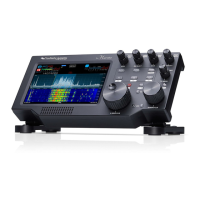FLEX-6000 Signature Series – Maestro User Guide
Page 157
Copyright 2019 FlexRadio Systems. All Rights Reserved.
mode, the reception bandpass is shown on the Panadapter as a light blue band while the transmit
bandpass is shown as a light red band. If the transmitter is not assigned to the Slice, a vertical dotted
red line marks the transmit frequency. The RIT indicator is green when RIT is active. Another long
press of the RX button disables RIT.
Similarly, a long press of the TX button in an Active Slice, activates the XIT (Xmit Incremental Tuning)
feature. XIT allows the Slice Receiver’s transmit frequency to be adjusted up and down with the
tuning knob while holding the reception frequency constant. In this mode, the reception bandpass
is shown on the Panadapter as a light blue band while the transmit bandpass is shown as a light red
band. The XIT indicator is red when XIT is active. Another long press of the TX button disables XIT.
The RIT/XIT step size is dependent on the mode assigned to the slice receiver. In AM/LSB/USB/FM
modes, RIT and XIT adjustments occur on 10Hz steps. In CW/RTTY/DIGU/DIGL modes, RIT/XIT
adjustments occur on 5Hz steps.
The Use VFO B Knob for VFO A RIT/XIT button on the Maestro tab of the Main Menu (see section
30.2, Maestro Tab) controls the details of RIT/XIT operation. When the option is not selected, the
VFO A and VFO B controls work independently as described above. When the option is selected, and
when Slice B is not active (RX button is off), then adjusting the Slice B Tuning knob will move the Slice
A transmit or receive frequency while holding the other constant. Adjusting the Slice A Tuning knob
moves both frequencies while holding the difference between them constant. When in RIT mode,
pressing the VFO B knob resets the received frequency to the transmit frequency. Similarly, when in
XIT mode, pressing the VFO B knob resets the transmit frequency to the received frequency.
The A>B button copies the settings of the A Slice to the B Slice. If no B Slice exists when the button
is pressed, a B Slice is created in the same mode as the A Slice but at a higher frequency determined
by the mode. In AM and FM modes, the new slice is located 10 KHz higher, in sideband modes, it is
5 KHz higher, in CW and RTTY modes, it is 1 KHz higher and in DIGU mode it is 500 Hz higher. If a B
Slice exists when the button is pressed, its frequency is set to the same value as the A Slice, but its
mode does not change. A second short press of the button causes the frequency of Slice B to be set
to Slice A. On the display, Slice B will cover Slice A until one of the slices is moved.
If two panadapters are displayed, and Slice A is in one while Slice B is in the other, then a short press
of the A>B button will change the frequency of Slice B to that of Slice A.
A long press of the A>B button (A>>B) activates the constant frequency difference feature. The A
and B Slices are locked together so that a change to the frequency of one of them changes the other
by the same amount in the same direction. The difference in the frequencies remains constant.
Another long press of this button disables this feature. The two Slices do not have to be located in
the same panadapter, or on the same band.

